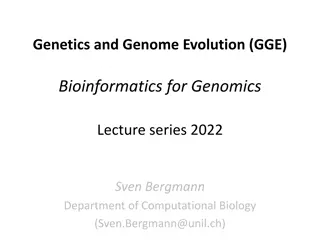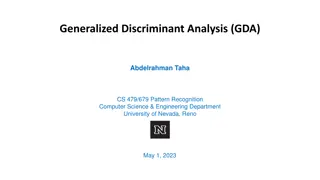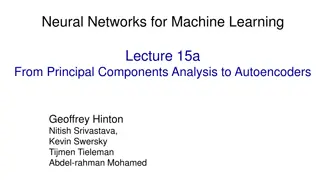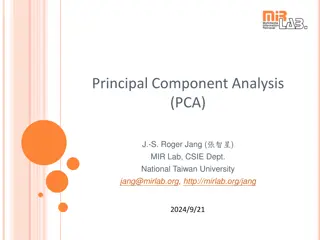
Understanding Principal Component Analysis (PCA)
Principal Component Analysis (PCA) is a statistical procedure used to convert correlated variables into linearly uncorrelated principal components. Its main goal is to identify patterns, detect correlations, and reduce dimensionality to increase computational efficiency while retaining information.
Download Presentation

Please find below an Image/Link to download the presentation.
The content on the website is provided AS IS for your information and personal use only. It may not be sold, licensed, or shared on other websites without obtaining consent from the author. If you encounter any issues during the download, it is possible that the publisher has removed the file from their server.
You are allowed to download the files provided on this website for personal or commercial use, subject to the condition that they are used lawfully. All files are the property of their respective owners.
The content on the website is provided AS IS for your information and personal use only. It may not be sold, licensed, or shared on other websites without obtaining consent from the author.
E N D
Presentation Transcript
Introduction Principal component analysis (PCA) is a standard tool in modern data analysis - in diverse fields from neuroscience to computer graphics. It is very useful method for extracting relevant information from confusing data sets.
Definition Principal component analysis (PCA) is a statistical procedure that uses an orthogonal transformation to convert a set of observations of possibly correlated variables into a set of values of linearly uncorrelated variables called principal components. The number of principal components is less than or equal to the number of original variables.
Goals The main goal of a PCA analysis is to identify patterns in data PCA aims to detect the correlation between variables. It attempts to reduce the dimensionality.
Dimensionality Reduction It reduces the dimensions of a d-dimensional dataset by projecting it onto a (k)-dimensional subspace (where k<d) in order to increase the computational efficiency while retaining most of the information.
Transformation This transformation is defined in such a way that the first principal component has the largest possible variance and each succeeding component in turn has the next highest possible variance.
PCA Approach Standardize the data. Perform Singular Vector Decomposition to get the Eigenvectors and Eigenvalues. Sort eigenvalues in descending order and choose the k- eigenvectors Construct the projection matrix from the selected k- eigenvectors. Transform the original dataset via projection matrix to obtain a k-dimensional feature subspace.
Limitation of PCA The results of PCA depend on the scaling of the variables. A scale-invariant form of PCA has been developed.
Applications of PCA : Interest Rate Derivatives Portfolios Neuroscience
Introduction Linear Discriminant Analysis (LDA) is used to solve dimensionality reduction for data with higher attributes Pre-processing step for pattern-classification and machine learning applications. Used for feature extraction. Linear transformation that maximize the separation between multiple classes. Supervised - Prediction agent
Feature Subspace : To reduce the dimensions of a d-dimensional data set by projecting it onto a (k)-dimensional subspace (where k < d) Feature space data is well represented? Compute eigen vectors from dataset Collect them in scatter matrix Generate k-dimensional data from d-dimensional dataset.
Scatter Matrix: Within class scatter matrix In between class scatter matrix Maximize the between class measure & minimize the within class measure.
LDA steps: 1. Compute the d-dimensional mean vectors. 2. Compute the scatter matrices 3. Compute the eigenvectors and corresponding eigenvalues for the scatter matrices. 4. Sort the eigenvalues and choose those with the largest eigenvalues to form a d k dimensional matrix 5. Transform the samples onto the new subspace.
Dataset Attributes : X O Blank Class: Positive(Win for X) Negative(Win for O)
Dataset top- middle- square top- right- square middle- left- square middle- middle- square middle- right- square bottom- left- square bottom- middle- square bottom- right- square top-left- square Class x x x x o o x o o positive x x x x o o o x o positive x x x x o o o o x positive o x x b o x x o o negative o x x b o x o x o negative o x x b o x b b o negative
References: [1]https://en.wikipedia.org/wiki/Principal_component_analysis# [2]http://sebastianraschka.com/Articles/2015_pca_in_3_steps.ht ml#a-summary-of-the-pca-approach [3]http://cs.fit.edu/~dmitra/ArtInt/ProjectPapers/PcaTutorial.pdf [4] Sebastian Raschka, Linear Discriminant Analysis Bit by Bit, http://sebastianraschka.com/Articles/414_python_lda.html , 414. [5] Zhihua Qiao, Lan Zhou and Jianhua Z. Huang, Effective Linear Discriminant Analysis for High Dimensional, Low Sample Size Data [6] Tic Tac Toe Dataset - https://archive.ics.uci.edu/ml/datasets/Tic-Tac-Toe+Endgame






















